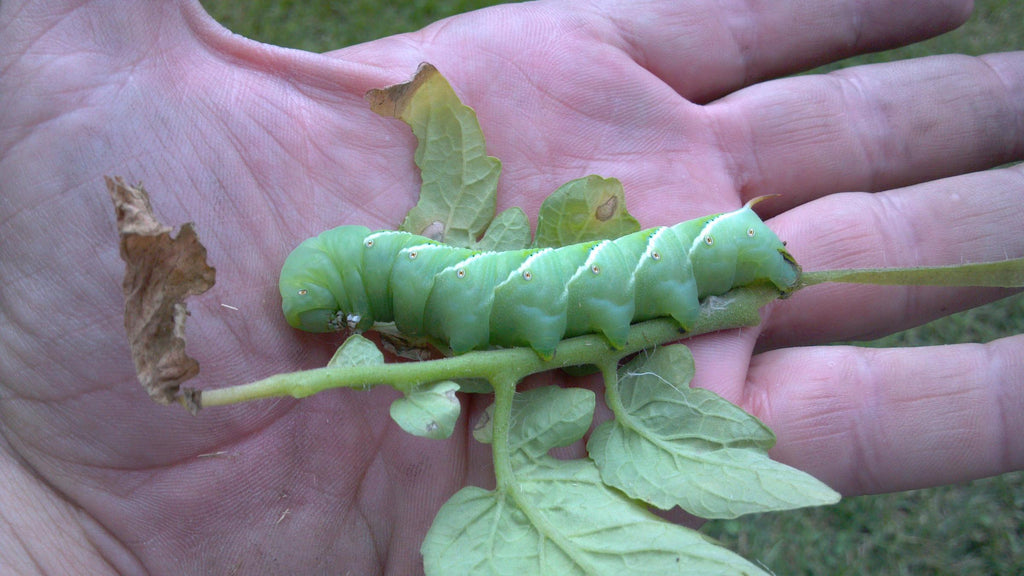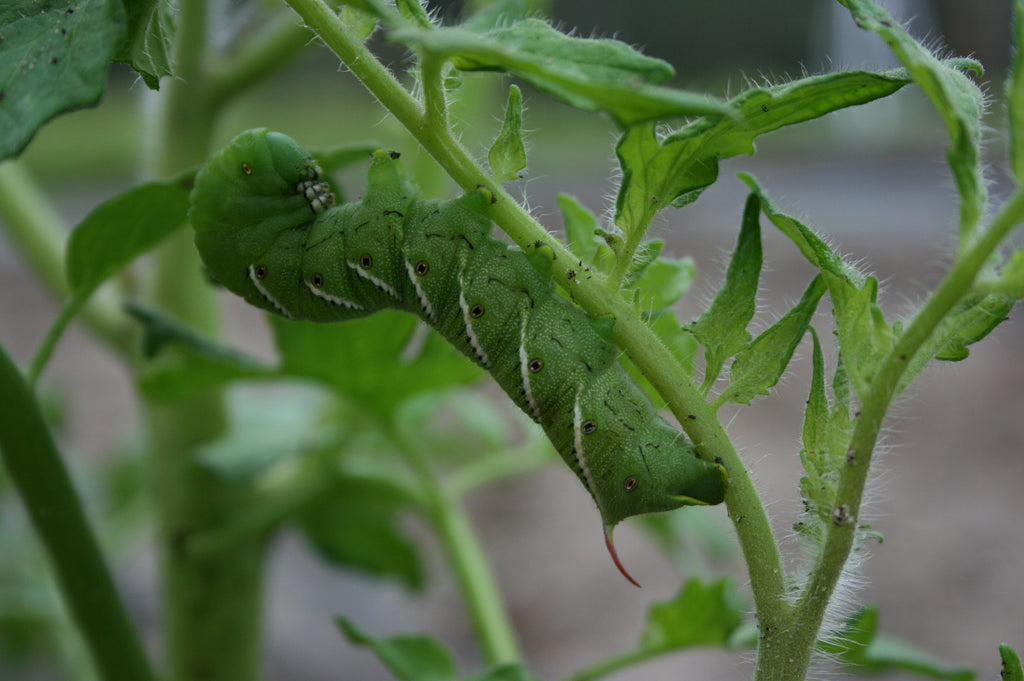
Tomatoes are likely the most popular garden vegetable, and with good reason. They come in a dazzling variety of types, colors, and sizes. They can be grown in containers, in the ground, and in nearly any size space. Finally, they’re absolutely delicious when fresh from the garden; home-grown tomatoes have a flavor that store-bought just can’t match. And that leads to one of the big problems with growing tomatoes at home: as much as we love them, various bugs and critters do too! Lots of things will try to eat your tomatoes—birds, squirrels, rats and mice, and we’ve published blogs about how to deal with that. However, one of the most dreaded tomato pests—the tomato hornworm—remains unaddressed in this blog, so we’re going to change that. What are tomato hornworms? How can you keep them away from your tomatoes? These are important questions for home gardeners, so let’s dig in!
What are Tomato Hornworms?
Tomato hornworms are the caterpillar stage in the life of Manduca quinquemaculata, also known as the the five-spotted hawkmoth and found throughout North America and Australia. A beautiful insect as moths go, the hawkmoth loves to lay its eggs and have its offspring develop on plants of the Solanacea family, which includes tomatoes, peppers, eggplant, and tobacco. The tobacco connection is important—M quinquemaculata is closely related to and often confused with the tobacco hornworm, Manduca sexta. In their caterpiller stages, the two species look nearly identical. Since they both love to live on and eat your tomato plants, the advice we give for dealing with one will apply to the other, so just assume that we’re talking about both throughout this article. If any of our readers have species-specific advice for dealing with them, please email us and let us know!

What do Hornworms do to Tomato Plants?
As caterpillars, hornworms are voracious eaters—and that’s where the trouble lies. While many bugs do minimal damage to plants at first, hornworms can strip a small tomato plant clean over the course of a day, such that the plant may not recover! These caterpillars eat the leaves, stems, and even the fruit of tomato plants, quickly and seemingly around the clock. Their color blends in with the surrounding foliage nearly perfectly, such that predators—including humans—often overlook them. These means they go on eating unchecked, and you and your tomato plants pay the price.
Signs of hornworm damage include bare stems and branches/vines on your tomato plants—it will look like something came along and just stripped the leaves and flowers off, which is exactly what happened. You may also notice black fass, or insect waste, on the leaves and stems or around the base of your plant, but this is less obvious. Eggs from the parent moth will appear near the stem of the plant, but as with the fass these are much less visible than the damage the caterpillars do.

How to Get Rid of Tomato Hornworms?
Getting rid of hornworms is best done proactively, by preventing them from taking up residence in your tomato plants in the first place. There are a few strategies that can work here, and they’re generally best used in combination. Tilling or refreshing your soil annually can do wonders for preventing hornworms, as it destroys or disrupts the pupae stage in which the caterpillars transition into moths. This disrupts the hornworm’s life-cycle and prevents more caterpillars in the season to come. There are a number of natural sprays and repellents that can be used—we recommend an all-natural or organic one—and likewise commercial products containing Bt (the Bacillus thuringiensis bacteria) can help either repel or naturally eliminate hornworms before they do much damage. Ensuring that your garden space is welcoming to the birds and insects that prey on hornworms is also useful—some species of wasp lay eggs on hornworm caterpillars, which their young eventually eat. There’s some irony in that, as these caterpillars do the same to our tomato plants! If hornworms have moved in, you may have to resort to manual removal. Don’t worry, it’s not scary—hornworms may look ferocious as insects go but they’re totally harmless to humans and even extended contact with them won’t hurt you. Carefully inspect your plant, stem by stem and branch by branch. When you find a hornworm of either variety, pull it off of the tomato plant and either crush it or toss it into a bowl of soapy water to be disposed of in the trash later. To be on the safe side, we don’t recommend tossing dead hornworms in your compost heap—although if you have chickens, fresh hornworms make a fine treat for them!
If hornworms have moved in, you may have to resort to manual removal. Don’t worry, it’s not scary—hornworms may look ferocious as insects go but they’re totally harmless to humans and even extended contact with them won’t hurt you. Carefully inspect your plant, stem by stem and branch by branch. When you find a hornworm of either variety, pull it off of the tomato plant and either crush it or toss it into a bowl of soapy water to be disposed of in the trash later. To be on the safe side, we don’t recommend tossing dead hornworms in your compost heap—although if you have chickens, fresh hornworms make a fine treat for them!
Hornworms and Tomato Plants
We won’t lie: if you’re growing tomatoes, hornworms will be a problem eventually. By staying vigilant and inspecting your plants, taking steps to prevent hornworms from infesting your garden, and eliminating them quickly if they do show up, you’ll go a long way towards managing their presence in your life. That is in part what gardening is about—learning to work with nature and manage the parts that we can while adapting to and living with the rest. If you have additional tips and tricks for dealing with tomato hornworms, let us know—we suspect this won’t be the last time we write about them!

Leave a comment